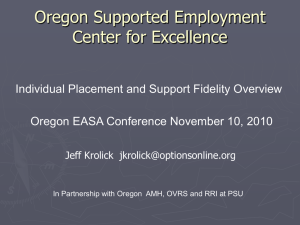New Jersey March 8, 2013
advertisement
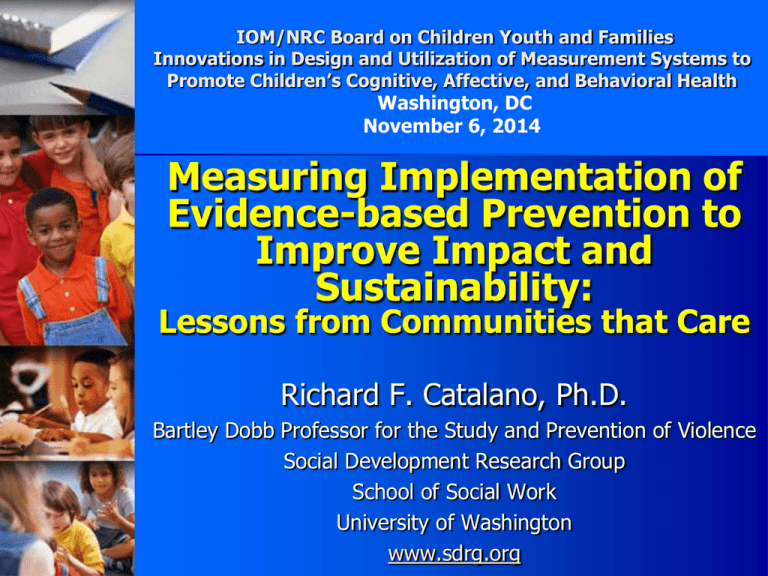
IOM/NRC Board on Children Youth and Families Innovations in Design and Utilization of Measurement Systems to Promote Children’s Cognitive, Affective, and Behavioral Health Washington, DC November 6, 2014 Measuring Implementation of Evidence-based Prevention to Improve Impact and Sustainability: Lessons from Communities that Care Richard F. Catalano, Ph.D. Bartley Dobb Professor for the Study and Prevention of Violence Social Development Research Group School of Social Work University of Washington www.sdrg.org Objectives How can communities incorporate the research base for prevention science into local prevention programming? How can communities build prevention infrastructure to ensure implementation fidelity? How does Communities That Care achieve fidelity of implementation, choose evidence based prevention programs, and implement them at scale with fidelity? 2 Preventing Mental, Emotional and Behavioral Disorders Among Young People: Progress and Possibilities A summary of the progress of prevention science 40 Years of Prevention Science Research Advances Etiology/Epidemiology of Problem Behaviors Identify risk and protective factors that predict problem behaviors and describe their distribution in populations and communities. Efficacy Trials Design and test preventive interventions to interrupt causal processes that lead to youth problems. Prevention Services Research Understand how to build effective infrastructure to use prevention science to achieve community impact. (O’Connell, Boat & Warner, 2009; Catalano et al., 2012) Despite this Progress… Prevention approaches that do not work or have not been evaluated are more widely used than those shown to be effective. (Ringwalt, Vincus et al., 2009) 5 The Challenge How can we build prevention infrastructure to increase use of tested and effective prevention policies and programs with fidelity and impact at scale… while recognizing that communities are different from one another and need to decide locally what policies and programs they use? 6 Building Prevention Infrastructure to Use the Prevention Science Research Base Build capacity of local coalitions to reduce common risk factors for multiple negative outcomes through: Assessing and prioritizing epidemiological levels of risk, protection and problems Choosing proven programs that match local priorities Implementing chosen programs with fidelity to those targeted Communities That Care: A Tested and Effective System for Community Wide Prevention CTC is a proven method to build community commitment and capacity to prevent underage drinking, tobacco use, and delinquent behavior including violence. – Idea developed in 1988, 15 years of implementation and improvement through community input prior to randomized trial – CTC has been tested in a randomized controlled trial involving 12 pairs of matched communities across 7 states from Maine to Washington. – CTC’s effects have been independently replicated in a statewide test in Pennsylvania. 8 Community Youth Development Study (CYDS): A Test of Communities That Care 24 incorporated towns PI: J. David Hawkins ~ Matched in pairs within state ~ Randomly assigned to CTC or control condition 5-year implementation phase 3-year follow-up post intervention Longitudinal panel of students ~ N=4,407- population sample of public schools ~ Surveyed annually starting in grade 5 9 Research Support from: Funders National Institute on Drug Abuse National Cancer Institute Center for Substance Abuse Prevention National Institute on Child Health and National Institute of Mental Health Human Development National Institute on Alcohol Abuse and Alcoholism State Collaborators Colorado DHS Alcohol & Drug Abuse Division Illinois DHS Bureau of Substance Abuse Prevention Kansas Dept. of Social & Rehabilitation Services Maine DHHS Office of Substance Abuse Oregon DHS Addictions & Mental Health Division Utah Division of Substance Use & Mental Health Washington Division of Behavioral Health & Recovery 10 CYDS Timeline: Youth Outcomes Spring ‘08 April ‘03 Start of Study Spring ‘06 3 years of CTC 2nd year of programs Spring ‘07 4 years of CTC rd 3 year of programs Completed Year 5 of the study End of CYDS funding and TA Spring ‘09 No CYDS funding or TA for 1 year Grade 7 Grade 8 Grade 10 Targeted risk Increased protection Targeted risk Spring ‘11 No CYDS funding or TA for 3 years Grade 12 Delinquency Delinquency Delinquency Delinquency (initiation) (initiation & prevalence) (initiation & prevalence) (initiation) Violence Violence (prevalence) (initiation) Alcohol Alcohol Alcohol (initiation & prevalence) (initiation) (initiation) Cigarettes Cigarettes Cigarettes (initiation) (initiation & prevalence) (initiation) Binge drinking (prevalence) Smokeless tobacco (initiation & prevalence) Hawkins et al., 2008, 2009, 2012, 2014 11 Communities That Care Builds Prevention Infrastructure Develops capacity to: Build coalition of diverse stakeholders Assess and prioritize risk, protection, and behavior problems with a student survey Address locally prioritized risks with tested, effective preventive interventions Support/sustain high fidelity implementation of chosen tested, effective preventive interventions with impact at scale Communities That Care: What is required? Commitment of key leaders/community members Funding for a community coordinator Training in CTC strategy and monitoring CTC implementation Weekly phone technical assistance, 2 site visits a year Assessment survey every two years Funding for selected programs Training in selected programs Fidelity and “reach” monitoring of selected programs CTC Coalition Capacity Building Trainings 1. Key Leader Orientation 2. Community Board Orientation Training 3. Community Assessment Training 4. Community Resource Assessment Training 5. Community Planning Training 6. Community Program Implementation Training 14 Communities That Care Process and Timeline Process • Assess readiness, Mobilize the community • Assess risk, protection and resources, • Develop strategic plan Evaluation Implement and evaluate tested, effective prevention strategies Increase in priority protective factors Increase in positive youth development Decrease in priority risk factors Reduction in problem behaviors Vision for a healthy community Measurable Outcomes 6-9 mos. 1 year 2-5 yrs. 3-10 yrs. 10-15 yrs. 1. Implementation Fidelity of CTC CTC Milestones and Benchmarks Assess key components of CTC strategy • Goals, steps, actions, and conditions needed for CTC implementation to build prevention infrastructure 16 CTC Milestones & Benchmarks Capacity Building and Assessment Listed in CTC training manuals and discussed in training workshops Incorporated into the Community Coordinator job performance objectives Reviewed by technical assistance providers and Coordinators during weekly phone calls Assessed by community coordinator, CYDS TA Staff, CTC trainer 17 Examples of CTC Milestones & Benchmarks Phase 1: Readiness for CTC Milestone: The community is ready to begin CTC ~ Benchmark: A Key Leader “Champion” has been identified to guide the CTC process Phase 5: Implementing the Community Action Plan Milestone: Implementers of evidence based programs, policies, or practices have the necessary skills, expertise, and resources to implement with fidelity ~ Benchmark: Implementers have received needed 18 training and technical assistance CTC Implementation Fidelity was Maintained over Time Phase 1 2 3 4 5 % of Milestones Completed Across Communities & Raters Year 1.5 Year 3 Year 4 Year 5 89 96 91 91 90 94 84 84 100 99 88 83 96 98 94 89 90 91 85 83 19 Fagan et al 2009 2. CTC Youth Survey Assesses young peoples’ experiences and perspectives. Provides valid and reliable measures of risk and protective factors across state, gender, age and racial/ethnic groups. (Arthur et al., 2002; Glaser et al., 2005) Identifies levels of risk and protective factors and substance use, crime, violence and depression for state, district, city, school, or neighborhood. Provides a foundation for selection of appropriate tested, effective actions. Monitors effects of chosen actions by repeating surveys every two years. The CTC Youth Survey is in the public domain www.communitiesthatcare.net 20 Why Assess Local Risk? Risk Profile A 100% Peer-Individual 90% 80% Community Family School Survey Participation Rate 2002: 79.7% Percent At Risk 70% 60% 50% 40% 30% 20% 10% 0% Estimated National Value Total Risk Peer-Individual Gang Involvement Intention to Use Drugs Depressive Symptoms Rewards for ASB Friends' Use of Drugs Interaction with Antisocial Peers Perceived Risk of Drug Use School Attitude Favorable to Drug Use Attitude Favorable to ASB Early Initiation of Drug Use Early Initiation of ASB Rebelliousness Low Commitment to School Family Academic Failure Parent Attitudes Favor Drug Use Parent Attitudes Favorable to ASB Family History of Antisocial Behavior Community Family Conflict Poor Family Management Perceived Availability of Handguns Perceived Availability of Drugs Laws & Norms Favor Drug Use Community Disorganization Low Neighborhood Attachment Percentage of Youth at Risk Communities have Different Priority Risks Risk Profile B 100% Total 90% 80% 70% 60% 50% 40% 30% 20% 10% 0% Communities Targeted a Variety of Risk Factors CTC Community RISK FACTORS 1 2 3 4 5 6 7 8 Laws and norms favorable to drug use x Low commitment to school x x Academic failure Family conflict x x X x x x x x x x Poor family management x x x x x x x x Parental attitudes favorable to problem behavior x x Antisocial friends X Peer rewards for antisocial behavior X Attitudes favorable to antisocial behavior X Rebelliousness X Low perceived risk of drug use 9 10 11 12 x x x x x x x x x x x x 23 x Community Choice Results in CTC Communities Implementing Different Tested-effective Programs Parent Training AfterSchool School-Based Program 2004-05 2005-06 2006-07 2007-08 All Stars Core Life Skills Training (LST) Lion’s Quest SFA (LQ-SFA) Olweus Bullying Prevention Program Program Development Evaluation Training Project Alert Project Northland-Class Action Towards No Drug Abuse (TNDA) 1 2 2 1 - 1 4* 3 2* 1 1 - 1 5* 3 2* 1 - 1 5* 3 2* 1 1* 2 Big Brothers/Big Sisters Participate and Learn Skills (PALS) Stay SMART Tutoring (generic programs) Valued Youth Tutoring Program 2 1 3 4 1 2 1 3 6 1 2 1 1 6 1 1 2 1 7 - Family Matters Guiding Good Choices Parenting Wisely Parents Who Care Strengthening Families 10-14 Total number of programs 1 6 1 2 27 1 7* 1 1 3 38 2 8* 1 3 37 2 7 2 2 39 *Program funded through local resources in some communities (Fagan et al., 2009) Balancing Research Goals and Community Practice The Challenge: – Measure fidelity across a range of programs – Encourage local ownership, high fidelity, and sustainability of prevention programs 3. Program Implementation Monitoring All CTC sites were expected to achieve high levels of fidelity: ~ Adherence: implementing the core content and components ~ Delivery of Sessions: implementing the specified number, length, and frequency of sessions ~ Quality of Delivery: ensuring that implementers are prepared, enthusiastic, and skilled ~ Participant Responsiveness: ensuring that participants are engaged and retaining material (Fagan et al., 2009) Fidelity Assessment Checklists Obtained from developers (9) or created by research staff (7) Provided similar information across programs Checklists were completed by program staff, coalition members, and reviewed locally as well as analyzed at the UW Building Capacity to Achieve High Fidelity Local monitoring and action – Community Program Implementation Training – CTC coalitions routinely tracked implementation – CTC coordinators and agency administrators provided implementers with feedback – Changes were made as necessary External monitoring/technical assistance – Regular telephone, email, and in-person TA to CTC coordinators and coalitions – Semi-annual reports summarized program successes, challenges & potential solutions Building Commitment to Fidelity through Observation Coalition members and local volunteers observed 10-15% of most programs Completed fidelity checklists to assess adherence ~ Rate of agreement w/implementers was 92-97% Adherence Rates Averaged across four years Percentage of material taught or core components achieved School-based 100 After-School Parent Training 90 80 70 60 60% fidelity standard 50 40 30 20 10 0 LST AS SFA Alert BPP PDE TNDA SS Tutor VY BBBS PALS SFP GGC PWC FM PW 30 Participant Responsiveness Averaged across all years Average score on 2 items reported by program observers School-based After-School Parent Training 5 4.5 4 3.5 3 2.5 2 1.5 1 LST All Stars SFA Alert BPP SMART PALS SFP GGC PWC Building Prevention Infrastructure: Capacity and Commitment Supports and Sustains Effective Prevention with Fidelity and Impact at Scale Build capacity and provide tools (eg., CTC Milestones and Benchmarks) to achieve effective prevention infrastructure Build capacity and provide tools to assess and prioritize local risk, protection and youth outcomes, match priorities to evidence based programs, and repeat assessment periodically Build capacity and provide tools to insure program fidelity and engagement of target population Create citizen-advocates-scientists to affect risk, protection, substance use, delinquency and violence community wide Thank You! CTC original materials are available for download and the new web streamed version of eCTC is described at: http://www.communitiesthatcare.net www.sdrg.org What Percent of the Population Must Be Reached to Achieve Collective Impact? CTC Results Achieved by Reaching 20-50% Number of students or families at least one session Program Type 2004-05 2005-06 2006-07 2007-08 School-Based 1432 3886 5165 5705 After-school 546 612 589 448 Parent Training 517 665 476 379 Note: Total eligible population of 6th, 7th, and 8th-grade students in 2005-06 was 10,031. (Fagan et al., 2009) Should Public Systems, for example Juvenile Justice and Child Welfare, Care about Community-based Prevention? Number Exposed to 10 or more Risk Factors Foster Care and Juvenile Justice v. General Population Medium Sized City 71% of system involved kids are high risk 35% of nonsystem involved kids are high risk FC=Foster care JJ= Juvenile justice High risk youth Ever in FC or JJ 13% Never in FC or JJ 87% 87% of Youth Exposed to 10 or more Risk Factors are not in Foster Care or Juvenile Justice Without Effective Prevention, the Public System may be Overwhelmed: Need to Reduce the Size of the Community Risk Reservoir Community acct. for 87% 10+ RFs CW/JJ acct. for only 13% 10+ RFs Current Efforts Underway to Disseminate CTC more Broadly in the U.S. • CTC for youth 0-10 to promote child wellbeing and reduce abuse and neglect • Providence, RI combining CTC processes with system reform for public child serving agencies and schools • Created eCTC materials for web delivery • Piloting eCTC in SW Practicum Agencies, Utah, Chicago • Established Center for CTC at UW Program Selection CTC coalitions selected evidence based programs to address their priority risk factors from a menu of programs* that all: ~ Were evaluated in at least 1 high-quality study ~ Showed significant effects on risk/protective factors, drug use, delinquency, or violence ~ Targeted schools, families and children in grades 5-9 [the age focus of the study] ~ Provided materials and training *As described in the CTC Prevention Strategies Guide; now recommending the Blueprints for Healthy Youth Development list
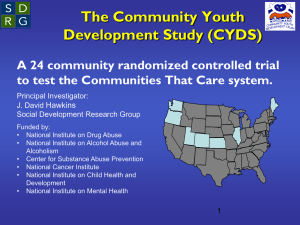
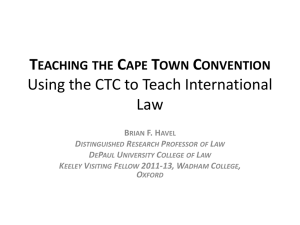



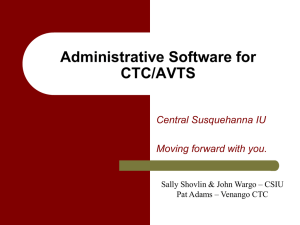
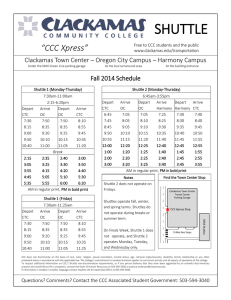


![PowerPoint Presentation [English]](http://s2.studylib.net/store/data/005278202_1-653405064f73381d06913a5b262d5b83-300x300.png)

